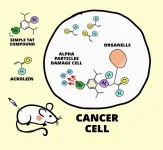(Press-News.org) Copenhagen, Denmark: More women are having just one embryo transferred per cycle of fertility treatment to get pregnant, according to research presented at the 39th annual meeting of the European Society of Human Reproduction and Embryology (ESHRE) [1].
Preliminary data from the ESHRE European IVF-monitoring Consortium (EIM) [2] shows that nearly three in five (57.6%) out of all in vitro fertilisation (IVF) and intracytoplasmic sperm injection (ICSI) procedures in 2020 in Europe involved the transfer of a single embryo. This compares with a figure of just over half (55.4%) for the previous analysis in 2019.
Around a third (37.6%) of these treatments in 2020 involved the transfer of two embryos, 2.1% involved three, and a tiny minority (0.2%) four or above. The figures for 2019 were 39.9%, 2.6% and 0.2%, respectively.
The reduction in multiple embryo transfers meant that singleton babies accounted for 88.8% of all ART deliveries compared with 87.7% the previous year. A minority were twins (11%) and triplets (0.2%), a drop from 11.9% and 0.3% respectively in 2019.
The number of treatment cycles from 1 January until 31 December 2020 also show a slight drop compared with the year before, according to the preliminary information from 1 326 clinics in 38 European countries.
A total of 843 776 cycles were carried out in 2020 and over one million in 2019. However, the authors say that the dataset is not yet complete, and the number of cycles will be higher by the time the full data will be reported.
The ESHRE EIM report represents the largest data collection on medically assisted reproduction in Europe. Spain, France and Germany were among countries with the highest number of treatment cycles.
Lead author Dr Jesper Smeenk, from the Elisabeth-TweeSteden hospital, in Tilburg (The Netherlands), said: “These preliminary findings show that live births resulting from fertility treatment in Europe continue to rise.
“Campaigns to raise awareness about multiple births have helped protect the health of women and their babies. The continued rise in single embryo transfer means women are less likely to face complications in pregnancy and during birth.
“The result has been that fertility treatments have become safer for mothers and babies without compromising success rates.”
The ESHRE EIM data were provided by national registries, medical associations and scientific organisations.
A total of 843 776 treatment cycles were carried out by 1 326 clinics offering assisted reproductive technology (ART) services in 2020. These fertility centres represented 82% of all clinics registered in the participating countries.
The majority of treatment cycles involved ICSI compared with just IVF alone (315 814 vs 135 803). The fact ICSI has overtaken IVF reflects a trend that has been ongoing since 2002, say the authors.
The number of cycles using frozen embryos was 279 126, which is comparable with 2019. Donated eggs were used in 60 521 treatment cycles, preimplantation genetic testing (PGT) in 47 793, and frozen eggs in 4 375.
A minority of cycles (344) featured in vitro maturation (IVM), which is a relatively new technique that does not require hormone drugs. This is because, after collection, the eggs are matured in the embryology lab, not in a woman’s body.
In addition, 1 209 institutions carried out 199 362 treatment cycles with intrauterine insemination (IUI) where sperm is injected directly into the womb. A total of 29 countries used the partner’s semen for IUI, and 22 used a donor’s (147 711 cycles versus 51 651, respectively).
Fifteen countries carried out a total of 18 270 fertility preservation procedures including egg, semen and ovarian tissue freezing. These techniques, which are often used to help cancer patients become biological parents in future, were carried out on patients both pre- and post-puberty.
Overall, clinical pregnancy rates [3] reported in 2020 for fresh embryo cycles were similar to those observed in 2019. The figures for IVF per aspiration – where a fine needle is used to retrieve eggs from a woman’s follicles – were 27.9% in 2020 versus 28.5% in 2019; and 32.9% in 2020 versus 34.6% in 2019 per embryo transfer. For ICSI, the rates were 24.3% and 32.2% in 2020 versus 26.2% and 33.5% in 2019, respectively, and 50.4% in 2020 versus 50.5% in 2019 for fresh embryo transfers with donated eggs.
This trend was repeated for pregnancy rates using frozen embryos per thawing cycle (34.6% in 2020 versus 35.1% in 2019), and using frozen eggs per thawing cycle (45.3% in 2020 versus 44.8% in 2019).
The authors say in their presentation that the findings are, for now, somewhat compromised by incomplete data returns, notably from the UK and some other smaller countries. On this basis, the authors say the results should be interpreted with caution and conclusions drawn when the complete report is published.
The chair of ESHRE, Professor Carlos Calhaz-Jorge from the Northern Lisbon Hospital Centre and the Hospital de Santa Maria in Lisbon (Portugal), was not involved in this research. He said: “Multiple births are a known risk factor for complications in pregnancy and childbirth, and can affect a child’s development.
“The hope is that this upwards trend in single pregnancies, as highlighted by the EIM data, continues.
“Clinics must always prioritise the safety of patients who undergo fertility treatment, and that of their offspring.”
(ends)
[1] Presentation no: O-153, “Assisted Reproductive Technology (ART) in Europe 2020 and development of a strategy of vigilance: Preliminary results generated from European registers by the ESHRE EIM Consortium”, presented by J Smeenk, session 48: European and Global ART monitoring, Hall D1, 11.45 hrs CEST, Tuesday 27 June 2023.
[2] This is the 24th ESHRE report based on data collected and analysed by EIM which is a group of representatives of national registries on assisted reproductive technology (ART). Since its first report in 1997, EIM has recorded almost 14 million treatments, with 2.8 million children born based on information from national registries, clinics, or professional societies. The findings have been reported in 23 manuscripts published in Human Reproduction and Human Reproduction Open.
[3] Clinical pregnancy refers to a pregnancy confirmed by an ultrasound scan that shows one or more gestational sacs – the fluid-filled structure surrounding an embryo – or definitive clinical signs of pregnancy.
Notes for editors
According to the UK Academy of Medical Science’s press release labelling system, this is a non-peer reviewed observational study in people.
Funding: none
When obtaining outside comment, journalists are requested to ensure that their contacts are aware of the embargo on this release.
For further information, contact:
Sophie Goodchild
Email: goodchildsophie@hotmail.com
Mobile: +44 (0)7767 325595
Emma Mason
Email: wordmason@mac.com
Mobile: +44 (0)7711 296986
Kerry Noble
Email: kerry_noble@hotmail.com
Mobile: +44 (0)7446 869 433
Laura Rossignoli at ESHRE
Email: Laura@eshre.eu
Mobile: +32 (0)499 92 32 49
The European Society of Human Reproduction and Embryology (ESHRE) is a European non-profit organisation with international membership, whose main mission is to promote the study and research of reproductive science and medicine as well as the treatment of infertility. Established in 1984, the Society now comprises more than 9.000 members and has become the leading Society in reproductive science and medicine worldwide. Our members are medical professionals, scientists and researchers working in reproductive science, reproductive medicine and embryology. We work in close partnership with the patient organisation Fertility Europe. The ESHRE annual meeting attracts over 11,000 clinicians, researchers, scientists, exhibitors. In 2022, participants from 130 countries attended. Seven of the top ten countries represented were European.
END
More women are using single embryos during fertility treatment
2023-06-27
ELSE PRESS RELEASES FROM THIS DATE:
Algorithm finds sperm in infertile men faster and more accurately than doctors
2023-06-27
Copenhagen, Denmark: A new artificial intelligence (AI) tool can identify sperm in severely infertile men in seconds compared to the hours it takes scientists, according to results presented today (Tuesday) at the 39th annual meeting of the European Society of Human Reproduction and Embryology (ESHRE) [1].
The study authors say the algorithm they have developed brings hope to men who want a biological child but have no sperm in their semen.
Currently, these patients must undergo a procedure where a portion of their testes is removed to help them become fathers. Embryologists extract sperm manually from this biopsy sample to fertilise the partner’s eggs ...
Lupus flare-ups strongly linked to specific bacterial growth in gut
2023-06-27
Recurrent bouts of systemic lupus erythematosus, marked by the body’s immune system attack of its own tissues, closely tracked with measureable upticks in growth in the gut of a certain species of bacteria.
New research from NYU Grossman School of Medicine shows that bacterial blooms of the gut bacterium Ruminococcus blautia gnavus occurred at the same time as disease flare-ups in five of 16 women with lupus of diverse racial backgrounds studied over a four-year period. Systemic lupus erythematosus involves damaging inflammation, especially in the kidneys, but also in joints, skin, and blood vessels. ...
This self-driving boat maps underwater terrain
2023-06-27
EL PASO, Texas (June 27, 2023) – Step aside self-driving cars, self-driving boats are here — and they can do more than take you on a cruise.
Researchers at The University of Texas at El Paso have constructed a fully autonomous boat that can carry out bathymetric surveys — surveys of the depth and terrain of bodies of water like oceans, rivers and lakes. The team hopes the robotic boat can help simplify the survey process, which usually takes a crew of individuals to complete, as well as assist ...
A new generic treatment for multiple types of cancer
2023-06-27
Researchers led by Katsunori Tanaka at the RIKEN Cluster for Pioneering Research (CPR) in Japan and Hiromitsu Haba at the RIKEN Nishina Center for Accelerator-Based Science (RNC) have developed a new technique that has the potential to generically treat several kinds of cancer, with fewer negative side effects than currently available methods. Published on June 27 in Chemical Science, the proof-of-concept study showed that tumors in mice grew almost three times less and survival was 100% after just one injection of a compound that is designed to emit small amounts of alpha radiation from the inside of cancer cells, thus killing them but sparing ...
Why Saudi Arabia's "The Line" isn’t a revolution in urban living
2023-06-27
In October, the excavation work for the superlative construction project began. What some consider an ideal ecological city, others call a promotional gimmick. Researchers from the Complexity Science Hub now show why The Line should not be a showcase for future cities.
"It's the embodiment of the dream to start from scratch and completely rethink a city," says Rafael Prieto-Curiel, who researches cities at the Complexity Science Hub. The Line is planned to be a city built from nothing in the desert. It is to consist of two gigantic, unbroken rows of skyscrapers, with living space in between. 170 kilometers long. 200 meters wide. 500 meters high, higher ...
Magnetic bacteria point the way
2023-06-27
Magnetotactic bacteria, which can align with the Earth’s magnetic field, have been discovered in a new location. Previously observed on land and in shallow water, analysis of a hydrothermal vent has proven that they can also survive deep under the ocean. The bacteria were able to exist in an environment that was not ideal for their typical needs. Magnetotactic bacteria are of interest not only for the role they play in Earth’s ecosystem, but also in the search for extraterrestrial life. Evidence of their existence can remain in rocks for billions of years. Their magnetic inclinations can also provide ...
Over 100 leaders in aging and longevity to present their latest research at the 10th ARDD
2023-06-27
June 27, 2023, the University of Copenhagen is excited to reveal the speakers, program and travel grants for the 10th Aging Research & Drug Discovery Meeting, the World's Largest Conference on Aging Research in the biopharmaceutical industry that will transpire on August 28 - September 1, 2023 on-site at the Ceremonial Hall, University of Copenhagen, and online.
According to the United Nations, the proportion of people aged over 65 now outnumber children younger than 5. The enormous growth in the elderly population is posing a socioeconomic challenge to societies worldwide, and necessitates new sweeping interventions for age-associated ...
A new method to keep thickening agents tiny in transport and big in application
2023-06-27
Osaka, Japan – Many commercial products such as food, cosmetics, and inks contain cellulose nanofiber (CNF) as a thickening agent. However, CNFs have some limitations that prevent their more widespread use. Now, researchers from Osaka University have demonstrated a method of dehydrating CNFs to a dense powder without affecting their three key properties. Their findings are published in Macromolecular Rapid Communications.
Video for your easy understanding
https://youtu.be/PAEd36v_SjI
CNFs are a popular thickening agent because small amounts in water have high transparency, high viscosity, and the viscosity ...
Two technology-based approaches that improved hand hygiene compliance are featured at infection prevention conference
2023-06-27
Orlando, Fla., June 27, 2023 – Hand hygiene is the simplest, most effective way to prevent the spread of infections in healthcare, yet healthcare worker adherence is often low. Infection preventionists at two health systems will present their successful hand hygiene interventions at the Association for Professionals in Infection Control and Epidemiology’s (APIC’s) Annual Conference in Orlando Florida, June 26-28.
University of Michigan Health sustains 95% hospital-wide hand hygiene compliance through creation ...
Updated guidance shows how hospitals should protect patients from resistant infections
2023-06-27
ARLINGTON, Va. (June 27, 2023) — A group of five medical organizations have released updated recommendations for the prevention of methicillin-resistant Staphylococcus aureus, known as MRSA, transmission and infection. MRSA causes approximately 10% of hospital-associated infections in the United States and such infections are associated with an increased risk of death. Certain infections caused by MRSA rose by as much as 41% during the pandemic after falling in preceding years.
Strategies to Prevent Methicillin-Resistant Staphylococcus aureus Transmission and Infection in Acute Care Hospitals provides evidence-based, ...





